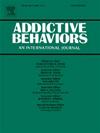Problematic pornography use and psychological distress: A longitudinal study in a large US sample
IF 3.6
2区 医学
Q1 PSYCHOLOGY, CLINICAL
引用次数: 0
Abstract
Problematic pornography use (PPU) has been positively associated with psychological distress (i.e., anxiety and depression) in numerous cross-sectional studies. In the present study, we examined the trajectory of PPU and its association with psychological distress over time. We conducted a one-year, three-wave longitudinal study among US adults (n = 4363, 46.4 % women, M(Age) = 50, SD(Age) = 16.15) and examined changes in PPU and psychological distress. Specifically, we assessed bivariate correlations and a random-intercept autoregressive cross-lagged panel model. PPU was assessed by the Brief Pornography Screen (BPS), and psychological distress was assessed by the Generalized Anxiety Disorder–2 (GAD-2) and the Patient Health Questionnaire-9 (PHQ-9). Between each six-month period, we found that BPS bivariate intercorrelations were strong (ρ = 0.712, 0.726) and BPS autoregressive paths remained moderate (β = 0.370, 0.408). Surprisingly, the positive associations between BPS and psychological distress scores from descriptive correlations were determined by a strong random-intercept correlation (r = 0.962), while cross-lagged paths remained small and negative (β=-0.189, −0.211, −0.214, −0.230, respectively). This suggested a robust trait-like between-person association between PPU and psychological distress, with negligibly small time-dependent within-person inhibitory effects occurring. PPU appears time-consistent (e.g., most participants remained in their initial clinical category) and robustly associated with psychological distress over time. We speculate that inhibitory within-person effects may possibly reflect short-term coping behavior and depressive drive inhibition, while in the long term, further manifesting PPU.
有问题的色情使用和心理困扰:一项对美国大样本的纵向研究
在许多横断面研究中,有问题的色情使用(PPU)与心理困扰(即焦虑和抑郁)呈正相关。在本研究中,我们研究了PPU的发展轨迹及其与心理困扰的关系。我们对美国成年人(n = 4363, 46.4%为女性,M(年龄)= 50,SD(年龄)= 16.15)进行了为期一年的三波纵向研究,并检查了PPU和心理困扰的变化。具体来说,我们评估了双变量相关性和随机截距自回归交叉滞后面板模型。通过简短色情屏幕(BPS)评估PPU,通过广泛性焦虑障碍-2 (GAD-2)和患者健康问卷-9 (PHQ-9)评估心理困扰。在每个6个月期间,我们发现BPS双变量相关性很强(ρ = 0.712, 0.726), BPS自回归路径保持中等(β = 0.370, 0.408)。令人惊讶的是,描述性相关性中BPS和心理困扰评分之间的正相关是由强随机截距相关性决定的(r = 0.962),而交叉滞后路径仍然很小且为负(β分别=-0.189,- 0.211,- 0.214,- 0.230)。这表明PPU和心理困扰之间存在一种强大的人格特质式的人际关联,发生了可忽略不计的小的时间依赖性人际抑制效应。PPU表现出时间一致性(例如,大多数参与者保持在他们最初的临床类别中),并且随着时间的推移与心理困扰密切相关。我们推测,人格内抑制效应可能反映了短期的应对行为和抑郁驱动抑制,而从长期来看,则进一步体现了PPU。
本文章由计算机程序翻译,如有差异,请以英文原文为准。
求助全文
约1分钟内获得全文
求助全文
来源期刊

Addictive behaviors
医学-药物滥用
CiteScore
8.40
自引率
4.50%
发文量
283
审稿时长
46 days
期刊介绍:
Addictive Behaviors is an international peer-reviewed journal publishing high quality human research on addictive behaviors and disorders since 1975. The journal accepts submissions of full-length papers and short communications on substance-related addictions such as the abuse of alcohol, drugs and nicotine, and behavioral addictions involving gambling and technology. We primarily publish behavioral and psychosocial research but our articles span the fields of psychology, sociology, psychiatry, epidemiology, social policy, medicine, pharmacology and neuroscience. While theoretical orientations are diverse, the emphasis of the journal is primarily empirical. That is, sound experimental design combined with valid, reliable assessment and evaluation procedures are a requisite for acceptance. However, innovative and empirically oriented case studies that might encourage new lines of inquiry are accepted as well. Studies that clearly contribute to current knowledge of etiology, prevention, social policy or treatment are given priority. Scholarly commentaries on topical issues, systematic reviews, and mini reviews are encouraged. We especially welcome multimedia papers that incorporate video or audio components to better display methodology or findings.
Studies can also be submitted to Addictive Behaviors? companion title, the open access journal Addictive Behaviors Reports, which has a particular interest in ''non-traditional'', innovative and empirically-oriented research such as negative/null data papers, replication studies, case reports on novel treatments, and cross-cultural research.
 求助内容:
求助内容: 应助结果提醒方式:
应助结果提醒方式:


